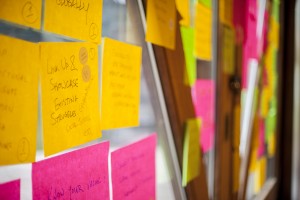 This week, we’re sharing reflections on the process and the ideas leaders in our Chief Executive Program: Community and Culture worked on during their Summit at Sundance last month. We encourage you to add your voice, your questions and experiences to the conversation, and to use the information and conversations to inform action!
This week, we’re sharing reflections on the process and the ideas leaders in our Chief Executive Program: Community and Culture worked on during their Summit at Sundance last month. We encourage you to add your voice, your questions and experiences to the conversation, and to use the information and conversations to inform action!
Communities, funders and the environment all shift over time. Arts and culture organizations can get stuck in patterns of doing and being. How might we change so that we remain relevant when our communities change?
I found the early discussion of this question particularly interesting. This idea came out of a majority of the participants saying that access and being accessible were top issues facing the field. In the lead-up to the Summit at Sundance we had a couple small group discussions to dig into this topic and try to arrive at a singular challenge to address. What was at the heart of this issue? What was something concrete that we could focus on during our time at Sundance? What was our design challenge in the parlance of Design Thinkers and human-centered designers and the disciples of IDEO. (Oh, my!)
The conversation included a handful of CEOs from around the country. People who run symphonies, art and children’s museums, performing arts venues and arts initiatives for a mid-size city. There were a number of ideas about what access, accessibility and community meant but the conversation kept circling back to the question of “Why?” The more we talked the more apparent it became that how you broaden access depends upon why you’re broadening access in the first place.
There are a number of forces – funding streams, changing demographics, failing business models – pushing us to broaden access to arts and culture. Each comes from a different motivation and may have a different definition of what “access” and “community” mean. As arts and culture leaders, we need to be more than just aware of the forces having an effect on us? We need to understand “Why?” and “What?” before we can effectively address this issue.
We must be relevant and we must be proactive… now and in the future. How do we do that? This was the challenge we settled upon. What do we need to do (or stop doing)? What are the structures or processes that will allow us to evolve with our communities, rather than reacting to change?
As a field, when we talk about these big issues like access and inclusion it’s very tempting to stay in that philosophical space – the land of “Why?” The real challenge, though, is to move past the “Why?” – to answer it, certainly – but to then drill into the “How?” What are some concrete ways we can bring this idea about, to operationalize it? What do you think?

I’m struck by two things from this post. First, I’m inspired by the thought of pausing to ask what is meant in different contexts when limited / lack of access to arts / creativity are important topics. I’ve heard many discussions about lack of access to art, but less frequently are those conversations accompanied with a deeper analysis of what kind of access / motivation to address this. I’m inspired to take a deeper pause the next time I encounter this kind of conversation.
I’m also struck by the thought of using some elements of design thinking to pilot small scale initiatives to increase access and then to listen to audience /”users.” Then perhaps we could “fail fast” to find how access is intertwined with questions about how we imagine varying audiences / community’s as active partners in art-making (even if they are audience).
Lots to think about….Thank you!